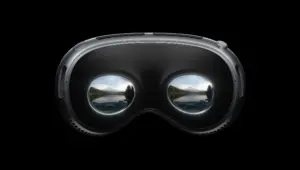A tip of the hat to Karl Guttag for highlighting a blog post by Hypervision about the Apple Vision Pro’s (AVP) optics. Hypervision contends that the AVP’s pancake optics are designed for edge-to-edge clarity, providing a large eyebox, which is crucial for maintaining visual clarity even with slight misalignments in eye position. Despite the limited IPD adjustment, the design likely compensates with a well-aligned optical and visual axis to maintain optimal visual quality.

Apple Vision Pro uses a special type of lens design called “pancake optics” to make the headset smaller and lighter. Traditional VR lenses can be bulky, but pancake lenses fold the light path to save space. The AVP has improved this design by using a curved component (the Quarter Waveplate or QWP), which helps the headset handle light better without losing quality. This is a significant innovation because it allows for better image clarity and wider field of view (FoV). The FoV is essentially how much of the virtual world you can see through the headset. Think of it like the difference between looking through a narrow tube versus a wide window.
The AVP overcomes this limitation by using a three-element pancake lens module. The distinct feature of this module is the varying thickness of the lens elements. The lens element near the display has a significantly thicker side compared to its top, while the middle lens element shows the opposite thickness pattern. This unusual design hints at the use of a specific patent, US20180120579A1 by Facebook, which offers a solution to the QWP deformation problem by embedding the QWP between two cylindrical surfaces.
The patent describes embedding the QWP between two cylindrical surfaces, which allows the QWP to maintain its flatness while being cylindrically rolled between the lens surfaces. This cylindrical configuration ensures that the QWP can effectively convert linear polarization to circular polarization without deformation.
Apple’s patent US20210132349A1, filed from February 2017, supports this design. The patent details a method where the QWP is cylindrically rolled between surfaces S6 and S7 of lenses 26 and 32, forming a single lens element capable of converting polarized light. This design innovation allows AVP to circumvent the flat surface requirement for the QWP, thereby enabling more optimized lens designs.
Regarding the Field of View (FoV) of the AVP, estimates based on the device’s pictures and known dimensions suggest a horizontal FoV between 100° and 110°. The peripheral FoV is larger than the rotational FoV due to the geometry where the pupil’s location is closer to the lens than the eye’s center of rotation. The monocular horizontal FoV is calculated to be 50° nasally and 60° temporally, totaling 110°, while the binocular horizontal FoV is 120°. The vertical FoV is 90°, with 45° each for top and bottom.
Further analysis of the AVP display, assuming an interpupillary distance (IPD) of 65mm and an eye relief (ER) of 12mm, suggests the uDisplay active area is 27.6mm by 22.8mm. These dimensions align with an aspect ratio that supports the FoV assumptions. The eye box is the area where your eyes need to be positioned to get the best image quality. A larger eye box is more forgiving, allowing you to move your head slightly without losing image clarity. Due to the advanced design of the AVP, the eye box might be smaller, meaning you need to keep your eyes well-aligned with the lenses to maintain the best image quality.
Pixel Per Degree (PPD) estimates, based on an assumed pixel size of 7.395 μm and display resolution, yield a PPD of approximately 34, which should be considered quite significant. Given potential non-linearities and exact specifications, the central PPD could vary by about 10%, possibly reaching up to 40 PPD.
Ultimately, the analysis has Guttag’s endorsement meaning that it seems to have caught the essence of what the AVP’s optics are capable of, and the Hypervision analysis suggests that, yes, the optics are impressive, if you have ideal viewing conditions. That is good news for Apple, but still, it doesn’t negate the general misgivings about the AVP as a practical headset or one that could change the limited market for it. It confirms that Apple was its usual self in defining and developing the core technologies but not its usual self when it came to creating the next “iPhone moment.”

